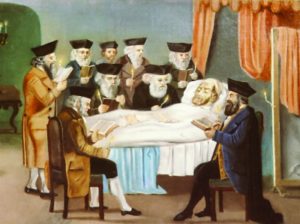There comes a time in each person’s life when the way in which he or she is to be buried is of paramount importance. One of the first tasks of a newly founded Jewish community, predating even the building of a synagogue, is to purchase a plot of land that will be used as a cemetery in which loved ones can be buried, as Abraham did for his wife Sarah.
During the late Rabbi Mel Glazer’s tenure at Temple Shalom in Colorado Springs, 2007-2017, he recognized and acted upon this basic human need and Jewish teaching. The introduction of a chevra kadisha (literally, “holy group”) in Colorado Springs was the result of Rabbi Glazer’s leadership.
The chevra kadisha is a group of people who prepare a body for burial.
According to Temple Shalom’s current rabbi, Jay Sherwood, the mitzvah that these people perform is the highest one possible, as one cannot be thanked for this sacred task.
Indeed, it is customary in some circles that the names of the persons belonging to a chevra kadisha are anonymous. If one runs across the group after they have accomplished the ritual preparation of a body, one does not thank them.
The chevra kadisha in Colorado Springs has two core groups: one for men and one for women. Membership is on a volunteer-only basis.
Due to a custom among some not to know the identities of the members, this article will report on conversations with the chair of each group using fictitious names.
The chair of the men’s group, “Drew,” began his involvement with the chevra kadisha approximately 10 years ago when Rabbi Glazer introduced the concept in Colorado Springs.
Drew is impressed by anyone who participates in the group. The eight men who perform the mitzvah work well together. The level of respect for the body and professionalism among the team members is high.
Drew considers this work the “ultimate mitzvah.” He enjoys seeing the transformation of a body to a clean, pristine envelope that is ready for the next step, burial.
He reports that he feels “uplifted and honored” to participate, that he is “lucky to have a community that cares enough to do this” and feels that this group takes “the best care of a person.”
Drew mentioned that he shared his experiences with the chevra kadisha with his own family upon the death of his mother.
The women’s group chair, “Naomi,” also began her participation in the chevra kadisha with Rabbi Glazer 10 years ago.
She says that she is strongly affected spiritually by the rituals and often feels chills, especially when dressing the body in “priestly garments.” This portion of the process makes her feel that the deceased is important in the eyes of G-d.
The prayers she remembers most poignantly are the priestly blessing and the prayers uttered directly to the deceased to ask for forgiveness for any mistakes they may have made during the process of preparation.
The ritual preparation, or taharah, of a deceased includes five core practices:
Sh’mirah — keeping vigil over the body from the time of death until burial;
Rehitzhah — washing the body;
Taharah — ritual purification of the body;
Halbashah — dressing the body in tachrikhim (shrouds); and
Hashkavah — placing the deceased in the coffin.
Are there any problems encountered during the preparation process? Both Drew and Naomi report that once in a while the body presents with abrasions, fluids, IV tubes or other medical devices. If a tube is removed, bleeding may result. It can be difficult to determine whether to deal with these devices or leave them; in these situations, the rabbi is consulted.
Drew tries to do his “homework” before he enters the room with a body to be prepared for what he may find. The entire process, also called Taharah, takes from two to two and-a-half hours.
Rabbi Jay Sherwood has had experience working with the deceased. He worked for a time at a cemetery in southern California.
Rabbi Sherwood and some chevra kadisha members from Colorado Springs will attend the conference of Kavod v’Nichum (the national organization for chevra kadisha groups) in June in Fort Collins.
The purpose of the conference is to spread education about the practical and spiritual mechanics of Taharah.
Rabbi Sherwood says that one does not have to be an expert to attend the conference or to become a chevra kadisha member. He says that there is a need for a chevra kadisha group in every city.
Rabbi Sherwood is planning to streamline the current process at Temple Shalom. He wants to make the Taharah manual more user-friendly.
The “rosh,” or facilitator, needs a full manual to direct the operations, but the other members do not need the directions.
The protocol of communication will also be streamlined at Temple Shalom. His goal is to become more organized for each ste[ of the process, so that specified steps will be outlined for group chairs, for a sh’mirah coordinator, trainers and other volunteers.
He says that an annual refresher course will be offered.
Rabbi Sherwood is happy to build on Rabbi Mel Glazer’s legacy. He calls volunteering for a chevra kadisha “adding holiness to the world.”
Copyright © 2019 by the Intermountain Jewish News

















